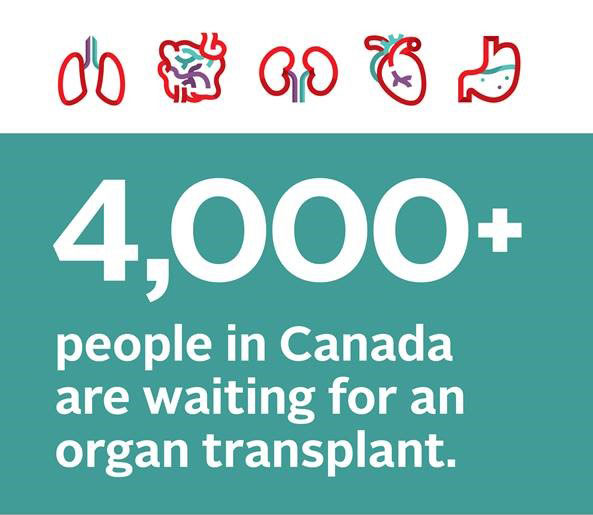Missed organ donor identification and referral causes preventable harm: new study estimates annual missed transplants in Canada

When an organ donation opportunity from a patient and their family is missed, there are life-threatening consequences for people waiting for a transplant. In 2018 alone, 223 Canadians died waiting for an organ transplant. Due to missed identification and referral, more than 350 potential deceased organ donation opportunities may have been overlooked between 2016-2018.
These findings are described in the new study Preventable Harm in the Canadian Donation and Transplantation System: a descriptive study of missed organ donor identification and referral in the Canadian Journal of Anesthesia, led by Dr. Samara Zavalkoff and supported by Canadian Blood Services and the Organ Donation and Transplantation Collaborative.
The organ donation process is complex with multiple steps. There are various reasons why a potential donor might be missed. It hinges on time-sensitive and sometimes uncomfortable conversations during tragic circumstances for families. Studies show the opportunity to become an organ donor differs based on your location — which city, which hospital, and even which department of the hospital.
“We see missed donation opportunities as ‘critical patient safety events’ that should never occur,” says Dr. Samara Zavalkoff, lead investigator and Medical Director of Patient Safety at the Montreal Children’s Hospital. “A missed organ donor deprives three people, on average, of lifesaving treatment.”
In a medical context, a ‘patient safety event’ is a deviation in standard practice that leads to patient harm. For example, a patient receiving the wrong medication.
Currently, the Canadian organ donation and transplantation system can’t quantify this preventable harm, and without this data there’s no way to plan and monitor improvement initiatives to reduce it. That’s why Dr. Zavalkoff and her collaborators set out to determine the national rate of donor identification and referral; estimate the number of missed donation opportunities from missed identification and referral; and quantify the preventable harm to Canadians patients and their families.
Investigators requested definitions and data to calculate identification and referral, consent, and approach rates from all Canadian organ donation organizations for 2016-2018. They then calculated the number of missed potential donors (eligible to be approached for organ donation) and estimated the associated preventable harm to patients at end-of-life and on transplant waitlists.
Annually, they found there were 63 to 76 missed potential donors not identified and referred (3.6–4.5 per million population) per year from four organ donation organizations, with available data; three of which have mandatory referral legislation. By applying each organization’s approach and consent rates for the corresponding year, they determined there were 37 to 41 missed donors (2.4 donor per million population) annually. Assuming on average three organs per donor, the theoretical number of missed transplants would range from 111 to 123 (6.4–7.3 transplants per million population) annually, for a total of 354 theoretical transplants over the study period.
Mandatory referral is legislation that mandates health-care teams to refer potential organ donors to local organ donation organizations. Five provinces (British Columbia, Manitoba, Ontario, Nova Scotia, and Alberta) have legislated mandatory referral.
“Right now, it’s the law to identify and refer potential donors, but that doesn’t go far enough. I believe we should also categorize these missed opportunities as ‘critical patient safety events’ which cause preventable harm,” says Dr. Zavalkoff.
Different jurisdictions across the country also use different definitions and data to measure missed donation opportunities.
“What we need is access to accurate and timely national data to monitor and measure missed donation opportunities. This is done through donor audits, which are medical chart reviews,” says Dr. Zavalkoff.
In partnership with Canadian Blood Services, Dr. Zavalkoff is working to achieve consensus on national definitions and minimum data collection requirements to help better understand and monitor these missed donation opportunities.
Preventable Harm in the Canadian Donation and Transplantation System: a descriptive study of missed organ donor identification and referral was financially supported by a grant from Canadian Blood Services and the Organ Donation and Transplantation Collaborative.
About the Organ Donation and Transplantation Collaborative
The Organ Donation and Transplantation Collaborative is an initiative led by Health Canada with provinces and territories health officials (except Québec), Canadian Blood Services, patients, families, clinicians, and researchers across Canada. The vision of the Collaborative is to facilitate collaboration on an organ donation and transplantation ecosystem that results in better patient outcomes and an increase in the number and quality of successful transplantations.
Canadian Blood Services – Driving world-class innovation
Through discovery, development and applied research, Canadian Blood Services drives world-class innovation in blood transfusion, cellular therapy and transplantation—bringing clarity and insight to an increasingly complex healthcare future. Our dedicated research team and extended network of partners engage in exploratory and applied research to create new knowledge, inform and enhance best practices, contribute to the development of new services and technologies, and build capacity through training and collaboration. Find out more about our research impact.
The opinions reflected in this post are those of the author and do not necessarily reflect the opinions of Canadian Blood Services nor do they reflect the views of Health Canada or any other funding agency.